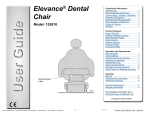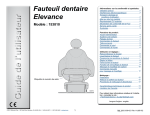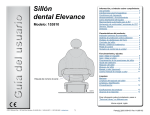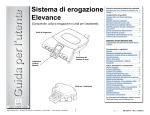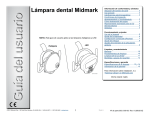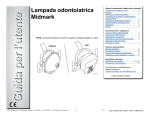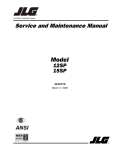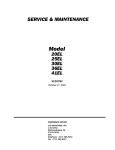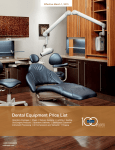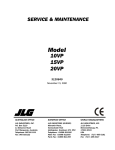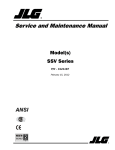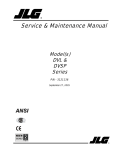Download 004-0752-00-Service Manual Elevance Chair
Transcript
Elevance® Dental Chair Model Numbers: Service Manual 153810 Language of origin: English FOR USE BY MIDMARK TRAINED TECHNICIANS ONLY 004-0752-00 (Revised: 7/23/2013) Diagrams © Midmark Corporation 2010 SF-1941 Theory of Operation Access Procedures Maintenance Troubleshooting Chart..........................................2 Power to the Chair................................................6 Base UP / DOWN Function.................................. 8 Back UP / DOWN Function................................ 10 Collision Protection System and the Home Function....................................................12 Diagrams Table of Contents Theory of Operation & troubleshooting PC Board Wiring Diagram, Harnesses & Information........................................................31 BASE UP Hydraulic Function............................ 32 BASE DOWN Hydraulic Function..................... 33 BACK UP Hydraulic Function............................ 34 BACK DOWN Hydraulic Function..................... 35 Position Programming........................................14 Hydraulic Valve Assembly Information............. 36 Chair Calibration and the Override Function... 16 Color Abbreviation Chart.................................... 37 Rotational Brake and Lockout Feature............. 18 ACCESS PROCEDURES Upholstery............................................................20 Lift Arm and Base Front Covers........................ 21 Pivot and Base Covers.......................................22 Seat Shrouds and Frame Covers..................... 23 Maintenance and Control settings Checking Oil Level..............................................24 Chair Calibration .................................................26 Manual Calibration..............................................27 Programming Chair Positions............................ 28 Synchronize the Wireless Remote.................... 29 Verifying LIN Connections.................................. 30 Revised: 9/29/2011 1 (*) Indicates multiple pages due to model / serial number break(s). Elevance Chair Troubleshooting Chart Condition Check Nothing happens when any button on any control is pressed. No relays can be heard energizing. If using a wireless remote Chair has power, but control buttons still do not operate chair. Some functions work with control buttons, but at least one function does not. © Midmark Corporation 2010 SF-1941 Solution 1. Green “power ON” indicator light, located on the chair base, is illuminated. Chair does not have power if green “power ON” indicator light is not on. 2. Verify power cord is plugged in. Plug in power cord. 3. Verify facility circuit breaker is not tripped. Determine why breaker tripped. Correct issue and reset breaker. 4. Fuse(s) F1, F2, or F3 on Chair PC Board are blown or open Replace bad fuse(s). Refer to PC Board wiring diagram. 5. Check for loose wire connections. Verify line voltage at J3 connection on the chair control PC Board. Tighten loose connections and refer to PC Board wiring diagram to determine loss of power at J3. 1. Check batteries. Replace depleted batteries with new ones. 2. Check battery leaf-spring contacts. Remove batteries and straighten leaf-springs to ensure that they make good contact with battery. Reference battery contacts illustration. 1. Verify chair is in calibration mode (SW2 Program Switch #4 ON) TIP: The wireless remote has an override feature - press and hold the P button and any arrow. This feature allows chair movements that override the software controlled movements. This moves the chair whenever it is powered. Move SW2 program switch #4 to OFF. Cycle power (plug then unplug power source from chair). 2. Chair may not be calibrated. Refer to Chair Calibration procedure. 3. Check all connections and harnesses. Repair or replace malfunctioning connector(s) or wire harnesses. Refer to PC Board wiring diagram for part numbers of harnesses. 4. If LIN Coupler is used to connect Assistant’s Unit keypad - verify LIN connections. Use LIN Coupler to verify LIN harness /LIN coupler functionality. 5. Chair PC Board is malfunctioning. NOTE: Incoming line voltage is present at J3 connector on Chair PC Board. LED is not ON next to the related relay when the function is operated. Replace Chair PC Board. 1. Safety bail limit switch contacts open on one or both limit switches or on the cuspidor limit switch (J6). These limit switches prevent the chair from going down. LED (D17) on Chair PCB is ON when limit switch contacts are CLOSED. Limit switches are wired in series with each other. Remove obstacle causing switch(es) to open or replace malfunctioning switch. 2. Verify continuity on all harnesses. Look for broken wires or loose connections. Repair or replace loose connectors or broken harnesses. 3. Perform a continuity check on each switch on membrane touchpads and foot control. Depressing a key on a touchpad closes the switch. Refer to touchpad wiring diagrams. If a switch does not show continuity when depressed to the closed position, then replace the membrane touchpad or foot control. 4. If hydraulic UP functions do not work, then verify the capacitor for the hydraulic motor pump by replacing it with a known good capacitor of the same rating. Replace malfunctioning capacitor. Replace malfunctioning Chair PC Board. 5. Chair PCB is malfunctioning. NOTE: Incoming line voltage is present at J3 connector on the Chair PCB. LED is not ON next to the related relay on the Chair PCB when the function is being operated. Check visually for damaged components or broken traces on PCB. 6. Back or base position sensor shows an open or shorted condition. Check connectors. Check continuity on all harnesses for broken wires or loose connections. Replace suspected back or base positioning sensor. Repair faulty connector(s). Replace harness(es). [Revised: 7/16/2013] 2 Elevance Chair Troubleshooting Chart (continued) Condition Check BACK UP function does not work. Nothing happens when any BACK UP button is depressed (all other functions work properly). BACK DOWN function does not work. Nothing happens when any BACK DOWN button is depressed (all other functions work properly). 1. Check for broken wires and loose connections for back up solenoid at J1 connector on Chair PCB. 2. “Open” coil on the back up solenoid valve. 3. Back Up solenoid valve is stuck in the closed position or clogged preventing hydraulic fluid flow. 4. Throttle valve (TV3) turned in too far or closed on hydraulic solenoid valve assembly. Adjust TV3 throttle valve. Travel time from end point to end point should be 15 seconds (+/- 1 second) with 180 lbs. (82 kg) on chair. 5. Hydraulic back cylinder leaks while using chair. Replace cylinder. 6. Potted back tilt sensor connection is loose or harness is broken. Tighten connection or replace potted back tilt sensor. 7. Potted back tilt sensor is damaged (open or shorted). Replace potted back tilt sensor. 8. On Chair PCB, LED D12 by K4 relay should be ON. Line voltage should be present at J1 terminals 1 and 2 to back up solenoid. Replace Chair PC Board. 1. Look for obstructions that are: 1) contacting the covers or cuspidor (if applicable), 2) actuating limit switches and 3) removing power from hydraulic functions. Remove obstructions. 2. Verify connections on safety bail limit switches are secure and on correct terminals. If a cuspidor is not installed a jumper must be in place on J6 on Chair PCB. NOTE: The normally closed safety bail limit switches open when the chair back or shrouds are deflected and the actuator bracket moves away from the switch. Connect harnesses correctly and verify that a jumper is on J6 if there is no cuspidor. 3. Verify connections on cuspidor safety limit switch are secure and on correct terminals. NOTE: The normally open cuspidor safety limit switch is tripped closed with cuspidor in normal operating position. The switch opens when cuspidor is deflected. Connect harnesses correctly. Throttle valve (TV4) turned in too far or closed on hydraulic solenoid valve assembly. Adjust TV4 throttle valve. Travel time from end point to end point should be 15 seconds (+/- 1 sec) with 180 lbs. (82 kg) on chair. 5. Back down solenoid coil has an open winding, is disconnected or has a broken lead. Repair wires and connections. 6. Back down solenoid valve is stuck in CLOSED position or is clogged, preventing hydraulic fluid to flow back into reservoir. Replace hydraulic solenoid valve assembly. 7. Potted back tilt sensor connection is loose or harness is broken. Tighten connection or replace potted back tilt sensor. 8. Potted back tilt sensor is damaged (open or shorted). Replace potted back tilt sensor . 9. On Chair PCB, LED D11 by K3 Relay should be ON. Line voltage should be present at J1 terminals 3 and 4 to Back Up solenoid. Replace Chair PC Board. 1. Broken wires or loose connections at BASE UP solenoid and at J1 on Chair PCB. Repair or replace harnesses or connections. 2. “Open” coil on the Base UP solenoid valve. 3. Base UP solenoid valve is stuck in the CLOSED position or clogged, preventing hydraulic fluid flow. Replace hydraulic solenoid valve assembly. Throttle valve (TV1) turned in too far or closed on hydraulic solenoid valve assembly. Adjust TV1 Throttle Valve. Travel time from end point to end point should be 20 seconds (+/- 1 second) with 180 lbs. (82 kg) on chair. 5. Hydraulic back cylinder leaks while using chair. Replace cylinder. 6. On Chair PC Board, LED D10 by K2 Relay should be ON. Line voltage should be present at J1 terminals 3 and 4 to Back up solenoid. Replace Chair PC Board. 4. BASE UP function does not work. Nothing happens when any BASE UP button is depressed (all other functions work properly). © Midmark Corporation 2010 SF-1941 Solution 4. [Revised: 7/16/2013] 3 Repair or replace harnesses or connections. Replace hydraulic solenoid valve assembly. Elevance Chair Troubleshooting Chart (continued) Condition Check BASE DOWN function does not work. Nothing happens when any BASE DOWN button is depressed (all other functions work properly). BASE and BACK DOWN functions do not work. Nothing happens when any BASE or BACK DOWN buttons are depressed (all other functions work properly). BASE and BACK UP functions do not work. Solution 1. Look for obstructions that are: 1) contacting the covers or cuspidor (if applicable), 2) actuating limit switches, and 3) removing power from hydraulic functions. Remove obstructions. 2. Verify connections on safety bail limit switches are secure and on correct terminals. If a cuspidor is not installed a jumper must be in place on J6 on Chair PC Board. NOTE: The normally closed safety bail limit switches open when the chair back or shrouds are deflected and the actuator bracket moves away from the switch. Connect harnesses correctly and verify that a jumper is on J6 if there is no cuspidor. 3. Verify connections on cuspidor safety limit switch are secure and on correct terminals. NOTE: The normally open cuspidor safety limit switch is tripped closed with cuspidor in normal operating position. The switch opens when cuspidor is deflected. Connect harnesses correctly. 4. Throttle Valve (TV2) turned in too far or closed on hydraulic solenoid valve assembly. Adjust TV2 throttle valve. Travel time from end point to end point should be 20 seconds (+/- 1 sec) with 180 lbs. (82 kg) on chair. 5. Base Down solenoid coil has open winding or a loose or broken lead. Repair wires and connections. 6. Base Down solenoid valve is stuck in CLOSED position or clogged, preventing hydraulic fluid flow back to reservoir. Replace hydraulic solenoid valve assembly. 7. On Chair PCB, LED D9 by K1 Relay should be ON. Line voltage should be present at J1 terminals 1 and 2 to Base down solenoid. Replace Chair PC Board. 1. Look for obstructions that are: 1) contacting the covers or cuspidor (if applicable), 2) actuating limit switches and 3) removing power from hydraulic functions. Remove obstructions. 2. Verify connections on safety bail limit switches are secure and on correct terminals. If a cuspidor is not installed a jumper must be on J6 on Chair PCB. NOTE: The normally closed safety bail limit switches open when the chair back or shrouds are deflected and the actuator bracket moves away from the switch. Connect harnesses correctly and verify that a jumper is on J6 if there is no cuspidor. 3. Verify connections on cuspidor safety limit switch are secure and on correct terminals. NOTE: The normally open cuspidor safety limit switch is tripped closed with cuspidor in normal operating position. The switch opens when cuspidor is deflected. Connect harnesses correctly. 1. Check hydraulic motor pump internal thermal overload. Check continuity between white and red motor leads and then between yellow and red motor leads. If no continuity - let motor cool 10 minutes or more and recheck. If overload remains open or no continuity registers, then replace hydraulic motor pump. Hydraulic pump operates intermittently. Running the motor continuously for a 30 second period will cause the overload to open. 2. Hydraulic fluid in oil reservoir is low. Fill oil reservoir to correct level. 3. Hydraulic motor pump leads are disconnected or loose. Connect electrical leads properly. Refer to PC Board wiring diagram. 4. Capacitor on hydraulic motor pump weak or inoperative. Replace capacitor with a known good capacitor of same voltage and manufactured rating. 5. Line voltage to chair is low. Line voltage should be between 110.0 to 126.0 VAC on a 115 VAC unit or 220 to 252 VAC on a 230 VAC unit. Correct low line voltage at source. Nothing happens when any BASE or BACK UP buttons are depressed (all other functions work properly). 6. Pressure relief valve is open or leaking. Replace pressure relief valve. BASE drifts down from elevated position. 1. If excessive hydraulic fluid is returning to reservoir through the vent tube of base cylinder, then cylinder is leaking past its piston seals. Replace Base hydraulic cylinder. BACK drifts down from elevated position. 1. If excessive hydraulic fluid is returning to reservoir through the vent tube of back cylinder, then cylinder is leaking past its piston seals. Replace Back hydraulic cylinder. Hydraulic Motor Pump continues to run after the chair reaches its Up or Down limit. 1. Potted back tilt sensor connection is loose on chair PC Board (J13). Tighten connection at J13. 2. Potted back tilt sensor is malfunctioning. Replace potted back tilt sensor. © Midmark Corporation 2010 SF-1941 [Revised: 7/16/2013] 4 Elevance Chair Troubleshooting Chart (continued) Condition Check Chair does not operate correctly with heavier loads. Solution 1. Line voltage supplied to chair is too low. Check supply line voltage at source. Voltage should be between 110.0 to 126.0 VAC on 115 VAC units or 220 to 252 VAC for 230 VAC units. 2. Weak capacitor on hydraulic motor pump. Replace capacitor with a known good capacitor of same voltage and manufactured rating. 3. Patient weight exceeds maximum limitation of 450 lbs. (204 kg). Follow maximum weight limitations. 4. Hydraulic fluid is leaking past hydraulic pressure relief valve. Excessive fluid is flowing back to reservoir during operation. Replace hydraulic solenoid valve assembly. 5. Hydraulic cylinder(s) leaking past piston seals, visible by excessive fluid returning to oil reservoir thru vent tubing. Replace hydraulic cylinder(s). BASE DOWN travel is too slow or too fast. 1. Base down (TV2) Throttle valve is either turned in too far, restricting flow back to reservoir or not turned in enough allowing too much flow, causing a faster descent. Adjust TV2 Throttle Valve. Travel time from end point to end point should be 15 seconds (+/- 1 sec) with 180 lbs. (82 kg) on chair. BACK DOWN travel is too slow or too fast. 1. Back down (TV4) Throttle valve is either turned in too far restricting flow back to reservoir, or not turned in enough, allowing too much flow, causing a faster descent. Adjust TV4 Throttle Valve. Travel time from end point to end point should be 20 seconds (+/- 1 sec) with 180 lbs. (82 kg) on chair. 2. Back lift spring is detached or broken. Back is designed to lower from top to bottom in 15 seconds with 80 lbs. (82 kg) load. Repair or replace back lift spring. 1. Restriction in suction line from oil reservoir resulting in some cavitation. Check for kinks in tubing and restrictions in suction line. Repair or replace tubing. 2. Internal parts failure in hydraulic motor pump. Replace hydraulic motor pump. Rotational brake not working. 1. Repair connections or replace harness. Reading Brake LEDs on Chair PC Board: D2 on - indicates switch (pedal) activated D17 on - indicates solenoid activated Press brake pedals individually and check LED D2 turns on. If LED D2 does not turn on, then check for switch or wiring issues. 2. Press brake pedals individually and check LED D15 turns on. If LED D15 turns on, then verify you can hear the solenoid energize. If LED D15 does not turn on, then test brake solenoid (J16) by moving plug to AUX (J2) on the PC Board - a good solenoid will energize immediately. Do not leave it plugged in for more than a few seconds to test it. Check for a physical obstruction at the brake pin or a missing/broken spring. Rotational brake will not release. 1. Loose connections or short in brake solenoid harness to J2 on Chair PCB. Repair connections or replace harness. 2. Verify continuity on brake solenoid coil. If coil shows open continuity, then replace solenoid. Rotational brake will not lock. 1. Spring attached to brake lever arm is missing or broken. Replace spring. Headrest difficult to adjust or does not stay in position. 1. Verify the friction cam adjustment. Reset the friction cam mechanism. SerenEscape Remote Control Heat light blinks. 1. Verify connection plugs on SerenEscape control box. Secure connection(s). 2. Verify red cable connection in upholstered back. Straighten bent pins. Wrap connections with electrical tape in a “figure 8” pattern. 3. Look for upholstered back, remote control or control box issues. Replace upholstered back, remote control or control box, in this order. 1. Verify connections at both ends of the SerenEscape power supply Secure connections. 2. SerenEscape power supply voltage is incorrect. Should be between 10 - 14 VDC. If voltage is incorrect, replace SerenEscape power supply. 1. Verify both black cable connections. Secure black cable connections with electrical tape wrapped in a “figure 8” pattern. Chair moves slowly or not at all under heavier loads. Hydraulic Pump is too noisy during BACK or BASE UP functions. Power light blinks. One or both massage motors do not operate. © Midmark Corporation 2010 SF-1941 [Revised: 7/16/2013] 5 Power to the Chair This illustration shows the components that affect all chair functions. See following page for a more detailed description. Power ON indicator illuminates when power is supplied AMP 1 2 3 4 Micro-controller Power Inlet 115 V~ (VAC) or 230 V~ (VAC) PC board regulators control and direct three different DC voltages to the appropriate connectors. Facility Power 115 V~ (VAC) or 230 V~ (VAC) 115 V~ (VAC) or 230 V~ (VAC) side Models: Regulated V (VDC) side 153810 Serial Numbers: © Midmark Corporation 2010 SF-1941 all [Revised: 6/6/11] Color Abbreviation Chart 6 Always verify model & serial number Power to the Chair Facility Power When the power cord is properly connected, facility power supplies 115 V~ (VAC) or 230 V~ (VAC) to the power inlet on the PC board. Power Inlet Supply voltage 115 V~ (VAC) or 230 V~ (VAC) comes thru the power inlet and passes thru three fuses on its way to the transformer. Transformer Supply line voltage 115 V~ (115 VAC) or 230 V~ (VAC) enters the transformer where it passes thru or is regulated to multiple, lower, V (VDC) voltages by three regulators. 115 V~ (VAC) or 230 V~ (VAC) Supply voltage is supplied to: Brake Release Solenoid thru J16 Hydraulic Pump thru J15 Hydraulic Valve Solenoids thru J1 Auxiliary Output thru J2 Regulated voltages: 12 V (VDC) is supplied to: Safety Limit Switches thru J4 Optional Cuspidor Safety Switch thru J6 Brake Safety Switch and Power ON Light thru J8 Communication Ports for Control Devices and J-Box connections J9 thru J12 Optional Cuspidor Power Connection thru J5 Optional Light Communication thru TB1 Power ON Light When proper power is supplied to the PC Board, the power ON light illuminates. Note The Power ON light operates on regulated (VDC) voltage coming directly from the 12 V BUS. The micro-controller has no connection to this light. Note Regulators (hardware) Electronic devices that regulate incoming 115 V~ (VAC) or 230 V~ (VAC) into more stable, V (VDC) voltages used by the PC board. PC Board Circuitry on the PC board provides pathways for voltages to connected components as well as pathways for input signals to and from the microcontroller. The same regulated voltage distributed to multiple devices is commonly called a BUS. 5V (VDC) is supplied to: Test Port thru J14 Micro-controller 3V (VDC) is supplied to: Back Tilt sensor thru J13 Micro-controller (software) The micro-controller processes input signals received from users and sensors, then sends the appropriate output signals to activate electronically controlled components. Models: 153810 Serial Numbers: © Midmark Corporation 2010 SF-1941 all [Revised: mo/dd/yr] 7 Always verify model & serial number Base UP / DOWN Function This illustration shows the components involved in the Base Up / Down function. See following page for more detailed description of the function. Hydraulics Electrical Power ON indicator (If light is OFF see Power to the Chair). Pump AMP 1 Oil Tank 2 3 4 Control Comm LEDs Hydraulic Valve Bank Hydraulic Valve Bank 1 P Base Cylinder Pump Facility Power 115 V~ (VAC) or 230 V~ (VAC) Power Inlet 115 V~ (VAC) or 230 V~ (VAC) Models: 2 3 4 Control Communication (VDC) (Comm) Ports 12 V 153810 Serial Numbers: © Midmark Corporation 2010 SF-1941 all [Revised: mo/dd/yr] Color Abbreviation Chart 8 Always verify model & serial number Base UP / DOWN Function Is there Power to the Chair? When voltage is present at J3 on the PC Board the Power light is ON. (Refer to Power to the Chair more information) Electric Power to Controls PC board components supply line and regulated voltages to components involved in the functions. Hydraulic Power to Controls The pressurized oil system provides fluid for all hydraulic operations. Link to Checking Oil Level for more information Relevant voltage readings: 115 V~ (VAC) at J3, Power inlet. (Read pins 1 & 3) 115 V~ (VAC) at J15, Pump Motor. (Read pins 1 & 2) 115 V~ (VAC) at J1 (Hydraulic Valve Bank) Read pins 9 + 1, 2, or 3 for Base UP Read pins 6 + 1, 2, or 3 for Base DOWN Look at LEDs for the J9 - 12, Control (Comm) Communication Ports to verify power and activity LED ON = device connection is seen by software LED BLINKING = comm port is receiving a command from a user Base Up Base Down When a Base Up button is pressed, the control device senses the command and converts it to an electronic signal. This signal is sent, thru the air, to the remote control base antenna (if wireless remote button was pressed) or by wire (if wired control button was pressed) to the chair PC board. When a Base Down button is pressed, the control device senses the command and converts it to an electronic signal. This signal is sent, thru the air, to the remote control base antenna (if wireless remote button was pressed) or by wire (if wired control button was pressed) to the chair PC board. The PC board supplies 115 V~ (VAC) to turn the Pump on, then, 115 V~ (VAC) to the Base Up Solenoid to open the Base Up valve. The PC board supplies 115 V~ (VAC) to the Base Down Solenoid which opens the Base Down valve. Gravity pulls the hydraulic fluid out of the base cylinder, into the oil tank, lowering the base cylinder shaft and the base. As the Pump Motor runs, fluid is pumped thru the open Base Up valve, filling the base cylinder, extending the shaft and raising the base. The PC board monitors sensory devices throughout the chair and determines if all preconditions required for the function are met. Base continues up until: 1. Base Up button is released. 2. Base reaches upper extent. 3. Thermal overload on the pump trips. Thermal overload switch resets after approximately ten minutes cooling time.) Base continues down until: 1. Base down button is released. 2. Base reaches lower extent. 3. Collision Protection System activates. Note The PC Board constantly monitors safety limit switches and sensory devices on the chair. The Collision Protection System activates when a chair cover (equipped with a safety limit switch) hits an object as it is moving down. The chair stops and raises slightly to disengage contact; The chair also beeps until the control button is released. Normal operation can resume once the object is removed and the safety limit switch becomes inactive. Models: 153810 Serial Numbers: © Midmark Corporation 2010 SF-1941 all [Revised: mo/dd/yr] 9 Always verify model & serial number Back UP / DOWN Function This illustration shows the components involved it the Back Up / Down function. See following page for more detailed description of the function. Hydraulics Electrical Power ON indicator (If light is OFF see Power to the Chair). Pump Back Cylinder AMP 1 Oil Tank Hydraulic Valve Bank 2 3 4 Control Comm LEDs Hydraulic Valve Bank 1 2 3 4 P Facility Power 115 V~ (VAC) or 230 V~ (VAC) Pump Power Inlet 115 V~ (VAC) or 230 V~ (VAC) Models: Control Communication (VDC) (Comm) Ports 12 V 153810 Serial Numbers: © Midmark Corporation 2010 SF-1941 all [Revised: mo/dd/yr] Color Abbreviation Chart 10 Always verify model & serial number Back UP / DOWN Function Is there Power to the Chair? When voltage is present at J3 on the PC Board the Power light is ON. (Refer to Power to the Chair more information) Power to Controls (VDC) to J9 thru J12 PC board supplies 12 V control pad communication ports. Back Up Back Down When a Back Up button is pressed, the control device senses the command and converts it to an electronic signal. This signal is sent, thru the air, to the remote control base antenna (if wireless remote button was pressed) or by wire (if wired control button was pressed) to the chair PC board. When a Back Down button is pressed, the control device senses the command and converts it to an electronic signal. This signal is sent, thru the air, to the remote control base antenna (if wireless remote button was pressed) or by wire (if wired control button was pressed) to the chair PC board. Outputs are activated in this sequence: 1. Pump Relay (D13) 2. Pump Triac (D1) 3. Back Up Relay (D12) If all safety bail limit switches are closed, the Back Down Relay (D11) is activated. The PC board supplies 115 V~ (VAC) to turn the Pump on, then, 115 V~ (VAC) to the Back Up Solenoid to open the Back Up valve. As the Pump Motor runs, fluid is pumped thru the open Back Up valve, filling the back cylinder, extending the shaft and raising the back. Relevant voltage readings: 115 V~ (VAC) at J3, Power inlet. (Read pins 1 & 3) 115 V~ (VAC) at J15, Pump Motor. (Read pins 1 & 2) 115 V~ (VAC) at J1 (Hydraulic Valve Bank) Read pins 7 + 1, 2, or 3 for Back UP Read pins 8 + 1, 2, or 3 for Back DOWN Look at LEDs for the J9 - 12, Control (Comm) Communication Ports to verify power and activity LED ON = device connection is seen by software LED BLINKING = comm port is receiving a command from a user Models: The PC board monitors sensory devices throughout the chair and determines if all preconditions required for the function are met. Back continues up until: 1. Back Up button is released. 2. Back reaches upper extent. 3. Thermal overload on the pump trips. (Thermal overload switch resets after approximately ten minutes cooling time.) Motion stops in this sequence: 1. Back Up Relay (D12) turns off 2. Pump Triac (D1) turns off 3. If no further movement after a few seconds, the Pump Relay (D13) turns off. The PC board supplies 115 V~ (VAC) to the Back Down Solenoid which opens the Back Down valve. Gravity pulls the hydraulic fluid out of the back cylinder back into the oil tank, lowering the back cylinder shaft and the back. Back continues down until: 1. Back down button is released. 2. Back reaches lower extent. 3. Collision Protection System activates. Note The PC Board constantly monitors safety limit switches and sensory devices on the chair. The Collision Protection System activates when a chair cover (equipped with a safety limit switch) hits an object as it is moving down. The chair stops and raises slightly to disengage contact; The chair also beeps until the control button is released. Normal operation can resume once the object is removed and the safety limit switch becomes inactive. 153810 Serial Numbers: © Midmark Corporation 2010 SF-1941 all [Revised: 9/12/2012 11 Always verify model & serial number Collision Protection System and the Home Function This illustration shows the safety bail limit switches involved in this system. See following page for a more detailed description of how this system works. Chair Pivot Cover Chair Back Lower Lift Cover Upper Lift Cover Lower Lift Cover Power ON indicator (If light is OFF see Power to the Chair). Base Cylinder Cover How Safety Bail Limit Switches Work Switches can be used as Normally OPEN or Normally CLOSED devices. The switch name describes the rest (normal) state. The active state is opposite the normal state. AMP Normally CLOSED (NC) Switch Normal State Plunger UP Active State (Not Shown) Plunger DOWN Current flows thru switch and exits NC path 1 Common (NC) Current flows into switch and exits NO path 2 3 4 (NO) = Current path Normally OPEN (NO) Switch Normal State Plunger DOWN Current flows into switch and exits NO path Active State (Not Shown) Plunger UP Current flows thru switch and exits NC path Models: Common (NC) (NO) Facility Power 115 V~ (VAC) or 230 V~ (VAC) 153810 Serial Numbers: © Midmark Corporation 2010 SF-1941 all [Revised: 6/6/11) Power Inlet 115 V~ (VAC) or 230 V~ (VAC) Color Abbreviation Chart 12 Always verify model & serial number Collision Protection System and the Home Function The system: The chair has six safety bail limit switches wired in series mounted in these areas: Lower Pivot Cover Upper Lift Arm Cover Lower Lift Arm Cover (right and left sides) Base Cylinder Cover Chair Back All of these switches are normally closed switches except for the Chair Back switch, which is a normally open switch. How functions are disabled: 1. When a cover equipped with a normally closed switch makes contact with an object as the base is moving downward, the switch opens. 2. When the back makes contact with an object as the back is moving downward, the switch actuator bracket moves away from the normally open switch, closing it. How are functions resumed: 1. Release the down control button. 2. Remove the object obstructing downward movement. 3. Press control buttons to resume operation. The Home Function The home position is a software directed base height, back up position convenient for installation procedures or patient access. Tap any lift arm or a pivot cover three times to activate the home function. Note Note The PC Board constantly monitors safety limit switches and sensory devices on the chair. The Collision Protection System activates when a chair cover (equipped with a safety limit switch) hits an object as it is moving down. The chair stops and raises slightly to disengage contact; The chair also beeps until the control button is released. Normal operation can resume once the object is removed and the safety limit switch becomes inactive. The chair beeps as it moves and stops beeping when it reaches the home position. Relevant voltage readings: 115 V~ (VAC) at J3, Power inlet. (Read pins 1 & 3) 12 V (VDC) at J4 Limit Switch Connector When any safety bail switch moves out of its normal position, power is removed from the Base and Back Down Hydraulic Valve Bank solenoids. LED indicators: After and obstruction is hit, the base (or back) stops lowering and raises a little so the object can be removed. Look at LED D17 to read status of all safety bail switches . LED ON = all switches are in normal state LED OFF = one or more switches is active Models: 153810 Serial Numbers: © Midmark Corporation 2010 SF-1941 all [Revised: 6/6/11] 13 Always verify model & serial number Position Programming This programming function allows a user to program and store up to four specified seat and back position configurations for a quick single button recall. See following page for a more detailed description of how this system works. Hydraulics Power ON indicator (If light is OFF see Power to the Chair). Electrical Back Tilt Sensor Pump AMP 1 Base Cylinder 2 3 4 Lift Arm Tilt Sensor Hydraulic Valve Bank 1 2 3 4 P Hydraulic Valve Bank Facility Power 115 V~ (VAC) or 230 V~ (VAC) Pump Power Inlet 115 V~ (VAC) or 230 V~ (VAC) Back Cylinder Models: 153810 Serial Numbers: © Midmark Corporation 2010 SF-1941 all [Revised: mo/dd/yr] Color Abbreviation Chart 14 Always verify model & serial number Position Programming To program a button to a specified position.... The system: Two tilt sensors (accelerometers) constantly monitor positions, relative to the floor, of the lift arm (base) and the back. This data is transmitted to the PC board where the software stores it, enabling a user specified position to be recalled using a single programmed, position button. A) Use the arrow buttons to move the chair to desired position. B) Press and hold any position button two seconds to set it for that position. The chair beeps three times to indicate the button is programmed. To recall a programmed position.... Recalling a programmed position: A) Press the desired position button (1, 2 3 or 4). The chair will move to the programmed coordinates stored for that button. When a programmed position is recalled, the PC board software activates all the required functions (at the same time) to return the base and back to the same coordinates the software has stored for that programmed button. Note The chair can be stopped any time during a programmed positioning sequence by pressing any other button on the control device. Relevant voltage readings: 115 V~ (VAC) at J3, Power inlet. (Read pins 1 & 3) 115 V~ (VAC) at J15, Pump Motor. (Read pins 1 & 2) 115 V~ (VAC) at J1 (Hydraulic Valve Bank) Read pins 7 + 1, 2, or 3 for Back UP Read pins 8 + 1, 2, or 3 for Back DOWN Read pins 9 + 1, 2, or 3 for Base UP Read pins 6 + 1, 2, or 3 for Base DOWN Look at LEDs for the J9 - 12, Control (Comm) Communication Ports to verify power and activity LED ON = device connection is seen by software LED BLINKING = comm port is receiving a command from a user 1 2 Position Buttons 3 4 P 1 4 DA2070 DA2069_a Models: 153810 Serial Numbers: © Midmark Corporation 2010 SF-1941 all [Revised: mo/dd/yr] 15 Always verify model & serial number Chair Calibration and the Override Function Chair Calibration is an automated routine of software controlled outputs working with continuous sensory inputs that keep the chair moving with precision, within an acceptable range of extents. The Override function allows a user to move the chair anytime it is powered, by bypassing software directed chair movements. See following page for a more detailed description of how this system works. Hydraulics Electrical Power ON indicator (If light is OFF see Power to the Chair). Program Dipswitches and Test Button Back Tilt Sensor Pump AMP 1 Base Cylinder 2 3 4 Lift Arm Tilt Sensor Hydraulic Valve Bank 1 2 3 4 P Hydraulic Valve Bank Facility Power 115 V~ (VAC) or 230 V~ (VAC) Pump Power Inlet 115 V~ (VAC) or 230 V~ (VAC) Back Cylinder Models: 153810 Serial Numbers: © Midmark Corporation 2010 SF-1941 all [Revised: mo/dd/yr] Color Abbreviation Chart 16 Always verify model & serial number Chair Calibration and the Override Function Chair Calibration is an automated, software directed routine of chair movements that identifies and stores data expressing the full range of acceptable chair movements. The Override function allows a user to move the chair anytime it is powered, by bypassing software directed chair movements. The system: Override Function Two tilt sensors (accelerometers) constantly monitor positions, relative to the floor, of the lift arm (base) and the back. This data is transmitted to the PC board where the software uses it locate the ends of travel points, calculate working values for these points and store these values in memory. The wireless remote has an override function, activated by pressing and holding the P button and any arrow button simultaneously. The override function allows a user to raise or lower the seat or back any time the chair is powered. The override function is directed by the user’s button inputs, which override software directed inputs. Chair Calibration Calibration is an automated routine of the full range of back and seat movements performed to collect, calculate and store data that expresses this motion in the software’s “language” and then test the results of the routine. Link to Chair Calibration Procedure Manual Calibration Manual calibration is a modified version of the chair calibration routine, allowing a user to manually set the travel limits of the seat and back for a customized application. Link to Manual Chair Calibration Procedure Relevant voltage readings: 115 V~ (VAC) at J3, Power inlet. (Read pins 1 & 3) 115 V~ (VAC) at J15, Pump Motor. (Read pins 1 & 2) 115 V~ (VAC) at J1 (Hydraulic Valve Bank) Read pins 7 + 1, 2, or 3 for Back UP Read pins 8 + 1, 2, or 3 for Back DOWN Read pins 9 + 1, 2, or 3 for Base UP Read pins 6 + 1, 2, or 3 for Base DOWN Look at LEDs for the J9 - 12, Control (Comm) Communication Ports to verify power and activity LED ON = device connection is seen by software LED BLINKING = comm port is receiving a command from a user Note Dipswitch #4 must be moved to the ON position to perform calibration. Dipswitch #4 must be moved to the OFF position for normal operation of the chair. Always cycle the power off/on when changing the dipswitch position. Models: 153810 Serial Numbers: © Midmark Corporation 2010 SF-1941 all [Revised: mo/dd/yr] 17 Always verify model & serial number Rotational Brake and Lockout Feature This illustration shows only the rotational brake components. For more details on how it works see the next page. Power ON indicator (If light is OFF see Power to the Chair). Rotational Brake Limit Switches Rotational Brake Facility Power 115 V~ (VAC) or 230 V~ (VAC) Power Inlet 115 V~ (VAC) or 230 V~ (VAC) Models: 153810 Serial Numbers: © Midmark Corporation 2010 SF-1941 all [Revised: mo/dd/yr] Color Abbreviation Chart 18 Always verify model & serial number Rotational Brake and Lockout Feature An electric rotational brake holds the chair in place by inserting a stop pin into one of a series of holes spaced around the pivot hub. A software controlled lockout feature completely locks out all chair movement when activated. Lockout Feature: The system: A lockout feature is provided to disable all electronic controls on the chair to prevent unintentional use. Stepping on either brake release pedal on the chair base frame, closes a limit switch enabling the brake solenoid to activate, drawing in the stop pin and allowing the chair to rotate freely. When the brake pedal is released, the solenoid releases the spring-loaded stop pin, allowing it to pop into the next hole it comes to in the pivot hub. Pivot Hub To release the lockout feature, press either of the brake release pedals five times in succession. The chair again beeps five times to indicate it is unlocked. (Buttons on control devices and the brake release pedals will function normally again.) Manual Release Relevant voltage readings: Brake Solenoid Stop Pin To activate the lockout feature, press either of the brake release pedals five times in succession. The chair beeps five times to indicate it is locked out. (Buttons on control devices and the brake release pedals will no longer work.) 115 V~ (VAC) at J3, Power inlet. (Read pins 1 & 3) 115 V~ (VAC) at J16, Rotational Brake (Read pins 1 & 2) 12 V (VDC) at J8, for Power Light and Brake Limit Switches Brake Pedal Models: 153810 Serial Numbers: © Midmark Corporation 2010 SF-1941 all [Revised: mo/dd/yr] 19 Always verify model & serial number Upholstery SerenEscape Heat and Massage Connectors (optional) Headrest Back Lift up and pull towards foot end to remove seat Mounting Post Tab Rotate Locking Knob Models: Slot Arm Screw 153810 Serial Numbers: © Midmark Corporation 2010 SF-1941 all [Revised: mo/dd/yr] 20 Always verify model & serial number Lift Arm and Base Front Covers Step 1: Raise chair and disconnect power supply. A) Raise chair approximately 26 to 28” from floor. B) Disconnect power supply from chair. warning Always disconnect chair from the power source before removing any covers. Failure to do so may result in personal injury. Equipment Alert Tap a lift arm or lower pivot cover three times to raise the chair to the pre-programmed “home” position; a convenient height for installation or patient access. Step 2: Remove upper arm lift cover. The chair beeps until it reaches the home position. A) Push clips in with a slotted screwdriver to release clips. B) Lift upper arm lift cover up to free front clips from shaft. Upper Lift Arm Cover Lower Lift Arm Cover Base Front Cover Step 4: Remove lower arm lift cover. A) Working one side at a time, move cover to the side and back to free it from mounting pins. DA3335i Step 3: Remove base front cover. A) Grasp bottom of base front cover B) Rotate up and out to remove. Models: 153810 Serial Numbers: © Midmark Corporation 2010 SF-1941 all [Revised: 4/11/13] 21 Always verify model & serial number Pivot and Base Covers warning Always disconnect chair from the power source before removing any covers. Failure to do so may result in personal injury. Step 1: Remove upper pivot cover. Two screws mount the upper pivot cover on the chair pivot. Switch Bracket Shoulder Bolts DA Lower Pivot Cover Upper Pivot Cover Step 2: Remove lower pivot cover. Cover hangs from two shoulder bolts and hooks over two pins on the switch bracket. Base Cover Step 3:Remove base cover. Push in with a screwdriver to release clip and lift base cover to remove. Models: 153810 Serial Numbers: © Midmark Corporation 2010 SF-1941 all [Revised: 4/11/13] 22 Always verify model & serial number Seat Shrouds and Frame Covers warning Seat Shroud (RH) Always disconnect chair from the power source before removing any covers. Failure to do so may result in personal injury. Shoulder Screw Washer Seat Frame Top Frame Cover Frame Cover (RH) Frame Cover (LH) Models: 153810 Serial Numbers: © Midmark Corporation 2010 SF-1941 all [Revised: mo/dd/yr] 23 Always verify model & serial number Checking Oil Level Step 1: Position chair. A) B) C) D) Rotate chair to the right for more room to work. Tap a lift arm cover three times to raise chair to the home position. Lower back until level with seat. Disconect chair from power supply. warning Always disconnect chair from the power source before removing any covers. Failure to do so may result in personal injury. Step 2: Remove upper lift arm cover. Lift Arm Covers A) Push in with a slotted screwdriver to release upper lift arm cover clips. Lift cover off chair. © Midmark Corporation 2010 SF-1941 [Revised: 02/04/2011] 24 Checking Oil Level - continued Step 3: Check oil level. A) B) C) D) Remove screw in cap bracket and rotate bracket to remove. Pull up on oil cap to remove from reservoir. Oil should be level with the base of the oil cap opening. Add only Hydraulic Oil with Viscosity ISOVG 32. if oil level is low. Equipment Alert Factory fill volume: 1.3 - 1.4 U.S. quarts (1.2 - 1.3 liters). Oil Cap Oil Level Cap Bracket Step 4: Install oil cap, cap bracket and lift arm cover. A) B) C) D) © Midmark Corporation 2010 SF-1941 [Revised: mo/dd/yr] 25 Push oil cap into tank opening. Place bracket over screw, rotate bracket to fit over oil cap and screw into tank. Replace upper arm lift cover - see Step 2. Connect chair to power supply. Chair Calibration procedure note Calibration is only required if the chair is not operating at all, or if it is not raising/lowering to the proper extents. Power to the chair must also be cycled after moving the #4 dipswitch to complete the procedure. Calibration should always be performed after replacing a chair’s PC Board, a tilt sensor or any lift mechanism. Movement of the chair is monitored by sensory devices that keep the chair within the range of motion accommodated by the drive mechanisms controlling the chair. The Calibration Mode is a programmed routine of chair movements that locates the end of travel points, calculates working values for these points, stores these values in memory and then tests the results of the routine. Follow these steps to calibrate a chair. Step 1: Unplug the chair from the power supply. Step 2: Step 6: Install PC Board Cover and Upper Lift Arm Cover. Plug chair back into to power supply. Activate control buttons to test chair operation. Remove the Upper Lift Arm Cover and PC Board cover (2 screws). Locate S1 and S2 switch components on the Chair PC board. Step 5: Unplug the Chair and move dipswitch #4 on S2 program switch out of Calibration Mode (OFF position). push in with a screw driver to release clips and lift upper arm lift Cover up to free front clips from shaft. lift Cover must be removed to access Chair pC board and cover. equipment alert Control buttons do not work normally during a Calibration Mode. Pressing any button (including the S1 Test pushbutton) will stop the chair movement and end the Calibration Mode. release clips (2) Step 4: Plug chair into power supply and press the TEST button on switch S1. As soon as the TEST button is pressed, Calibration begins. Step back and allow the chair to complete all 3 up/down cycles of the calibration routine. Chair pC board Note: The chair emits a short beep every 2 seconds while calibrating. When finished calibrating the chair emits 3 long, confirmation beeps. Step 3: The Calibration Mode has failed if the chair emits 1 long beep at the end of the calibration mode. Move the #4 dipswitch on the S2 program switch to the Calibration Mode position (ON). © Midmark Corporation 2010 SF-1941 Chair Calibration Page Anchor [Revised: 4/11/13] 26 Manual Calibration - use to set your own high and low extents for base and back travel. note Manual Calibration is only required to modify one or more of the limit of travel extents the base and back are set to originally. Power to the chair must be cycled after dipswitch #4 is returned to OFF position to complete the procedure. Base and back movements are monitored by sensory devices that keep them within a controlled range of extents. Manual Calibration is a modified calibration routine that allows you to set your own end of travel points, stores these values and then tests the results of the routine. Below is the Manual Chair Calibration procedure. Manual Calibration... A) Unplug chair from power supply. B) Remove uper lift arm cover and PC Board cover (two screws). Locate S1 and S2 switches on the PC board. C) Move dipswitch #4 on the S2 Prog SW to ON position. D) Plug chair into power supply, press and hold the TEST button on S1 switch (for five seconds). Listen for a beep to indicate it is in Manual Calibration mode. Beeps continue, one every 5 seconds, as long as you are in manual calibration. E) Extents can be manually set or skipped for each of these base and back travel points using the same keypad selections. Extents must always be set in this order: Base Low Back High Base High Back Low push in with a screw driver to release clips and lift upper arm lift Cover up to free front clips from shaft. lift Cover must be removed to access Chair pC board and cover. release clips (2) To set an extent: Move base or back to desired extent, then press and hold button 1 for two seconds to set the extent. Two beeps indicate extent is set. Chair pC board OR, to skip setting current extent: Press and hold button 4 for two seconds. Two beeps indicate extent remains at chair limit. Note: You can abort the manual calibration procedure any time by pressing the TEST button on S1 switch. Dipswitch #4 F) As soon as the final (Back High) extent is set the calibration routine begins. Step back and allow the chair to complete the necessary number of up/down cycles, which takes a few minutes. Manual Calibration continued... Note: The chair emits a short beep every 2 seconds while calibrating. When calibration is successful, the chair emits three long, confirmation beeps. G) Unplug chair from power supply and move dipswitch #4 on S2 program switch out to OFF position. H) Install covers (see B). I) Plug chair back into to power supply. J) Activate keypad and remote buttons to test operation. If calibration failed, the chair emits one long beep at the end of the routine. Repeat entire Manual Calibration. © Midmark Corporation 2010 SF-1941 Manual Calibration Page Anchor [Revised: 4/11/13] 27 programming Chair positions To program a button to a specified chair position.... A) Use the arrow buttons to move the chair to desired position. B) Press the Program Button. You will hear a single beep to indicate you are in the program mode*. C) Press the desired Position Button (1, 2, 3, or 4) to set the programmed position to that button. You will hear three beeps to indicate the button is programmed. note The chair can be stopped any time during a programmed positioning sequence by pressing any other button on the control device. alternate/foot Control programming Method: With the chair in the desired position, you can just press and hold a position button 2 seconds. The chair will beep three times to indicate the button is programmed. * The Control device gives you 3 seconds to press (program) a Position button after you are in the Program mode. After 3 seconds the control returns to the normal operating mode. 2 all the numbered buttons are position buttons 1 3 1 4 4 DA2070 special programming features The number 4 Position Button is capable of being programmed to invoke any one of these three different functions. program button 1 2 1 2 3 4 A) The Cuspidor Return Function. B) The Return to the Last Position Function. C) Function the same as any other Position button. Which of these functions the 4 button invokes is dependant on a dipswitch setting on the PC Board and should only be changed by a service technician. 3 4 P DA2071 To recall a programmed position.... Press desired Position Button (1, 2, 3, or 4). DA2069_a © Midmark Corporation 2010 SF-1941 Programming Chair Positions [Revised: mo/dd/yr] 28 synchronize the Wireless remote If nothing happens when any button on the Wireless Remote is pressed and no led lights on the PC board flash, the remote either needs new batteries or needs to be synchronized. To synchronize the remote: 1. Chair must be Powered ON. 2. Verify that Chair has been calibrated. (Refer to Chair Calibration procedure in Installation Guide 003-1923-99). 3. Remove Upper Arm Lift Cover* and the PC Board cover (two screws). 4. Locate the S2 PROG SW on the PC board and set the dipswitch 4 to the ON position. Listen for two beeps. 5. Press and hold buttons 2 and 3 on the remote within three seconds from moving dipswitch 4. Listen for three short beeps from the Chair then three beeps from the Remote. 6. Set dipswitch 4 to the OFF position to complete the synchronization process. 7. Replace PC Board & Upper Arm Lift covers. * push in with a screw driver to release clips and lift upper arm lift Cover up to free front clips from shaft. lift Cover must be removed to access pC board cover. Battery Contacts Leaf-Springs Chair pC board Clips DA2551i © Midmark Corporation 2010 SF-1941 Synchronize Remote Dipswitch 4 [Revised: 7/16/13] 29 Verifing LIN Connections LIN Coupler Step 1: Use LIN Coupler to check connectors. A) Unplug LIN connections from the LIN coupler. B) Remove two screws and the metal cover from the LIN coupler. Step 2: Check for faulty O (outgoing) harness. Replace O if the I (incoming) harness illuminates the LED when plugged into either side. LED Step 3: Check for a faulty LIN Coupler. The LIN coupler is faulty if the I harness illuminates the LED ONLY when plugged into the LED side. Step 4: Check for a faulty I harness. Replace the I harness if it does not illuminate the LED when plugged into either side. Note: This check is only valid when power is present in the I harness. © Midmark Corporation 2010 SF-1941 [Revised: 3/7/2013] 30 warning Use caution when operating equipment with covers removed. PC Board Wiring Diagram, Harnesses & Information PC Board Information Outputs Potted Back Tilt Sensor (includes harness) Chair Back 3 [VDC]) Chair Safety Bail Limit Switches (12 [VDC]) Assistant’s Chair Back COM Rotational Brake Solenoid 115 or 230 V~ COM COM NC NO NO NC NC NO Lower Lower Upper Lift Cover Lift Cover Lift Cover COM NO NC NO NO Base Cylinder NC NO NC 115V~ Motor Capacitor (45 Mfd, 220V~ (VAC) 230V~ Motor Capacitor (14 Mfd, 420V~ (VAC) Thermal Overload 115 or 230 V~ Back Down Buzzer Back Up LED K1 Base Down D9 K2 Base Up D10 K3 Back Down D11 K4 Back Up D12 K5 Triac Pump-R Pump-T K6 COM COM COM NC NC NO PC Board Description Work Together Rotational Brake D13 D1 D2 Indicator LEDs LED Brake (comes on when break pedal is pressed) D15 OK (comes on when both limit switches J5 and J6 are closed) D17 * Foot Control (option) D22 Dental Light (option) D18 * Remote Control Base Station (option) D20 Assistant’s Unit Keypad (option) D21 Delivery Unit Keypad (option) D23 Extra (used for options) D19 * One of these options is required Base Down Information Base Up Connector Auxilarty Output (Line VAC) J2 Cuspidor Power and Rinse J5 Test Plugs for Factory Use Only Solenoids Keypad Communication Lines Hydraulic Valve Assembly (115 or 230 V~ [VAC]) Communication Terminal for non-chair mounted Lights J7 & J14 J9 - 12 TB1 PC Board Wiring Diagram and Harnesses: Elevance Chair Item A Chair with no cuspidor has a jumper across this connector and across J6 (cuspidor limit switch). Description A Safety Bail Harness 015-2239-00 B Brake Release / Power Light Harness 015-2237-00 C Potted Back Tilt Sensor 015-2682-02 D Cuspidor Power / Limit Switch Harness 015-2323-00 E Solenoid Adapter Harness 015-2321-00 F Pump Adapter Harness 015-2320-00 G Rotational Brake Solenoid Harness 015-2319-00 Color Abbreviation Chart © Midmark Corporation 2010 SF-1941 [Revised: 9/10/12] 31 Part Number BASE UP Hydraulic Function Solenoid Valve Unit SV1 P Base Up Solenoid (Open) Pressurized By Pump Return By Gravity SV3 Back Up Solenoid (Closed) Suction Created By Pump No Flow Energized Device PRV Pressure Relief Valve (Closed) TV1 Throttle Valve Base Up CV1 Check Valve Base Up / Down (Open) CV2 Check Valve Back Up / Down (Closed) TV3 SV2 Base Down Solenoid (Closed) Pump (Running) SV4 Back Down Solenoid (Closed) TV2 Throttle Valve Base Down TV4 R Base Damper Back Damper TV5 Throttle Valve Base Function TV6 Throttle Valve Back Function A B Vent Base Cylinder (Extending) Vent Reservoir Back Cylinder Color Abbreviation Chart © Midmark Corporation 2010 SF-1941 [Revised: mo/dd/yr] 32 BASE DOWN Hydraulic Function Solenoid Valve Unit P Pressurized By Pump SV3 Back Up Solenoid (Closed) SV1 Base Up Solenoid (Closed) Return By Gravity Suction Created By Pump No Flow PRV Pressure Relief Valve (Closed) Energized Device TV1 Throttle Valve Base Up CV1 Check Valve Base Up / Down (Closed) CV2 TV3 SV4 Back Down Solenoid (Closed) SV2 Base Down Solenoid (Open) TV2 Throttle Valve Base Down Pump (Off) TV4 R Back Damper Base Damper TV6 Throttle Valve Back Function TV5 Throttle Valve Base Function A B Vent Base Cylinder (Retracting) Vent Reservoir Back Cylinder Color Abbreviation Chart © Midmark Corporation 2010 SF-1941 [Revised: mo/dd/yr] 33 BACK UP Hydraulic Function Solenoid Valve Unit P Pressurized By Pump SV3 Back Up Solenoid (Open) SV1 Base Up Solenoid (Closed) Return By Gravity Suction Created By Pump No Flow PRV Pressure Relief Valve (Closed) Energized Device TV3 Throttle Valve Back Up CV1 TV1 CV2 Check Valve Back Up / Down (Open) Pump (Running) SV4 Back Down Solenoid (Closed) SV2 Base Down Solenoid (Closed) TV2 TV4 R Back Damper Base Damper TV5 Throttle Valve Base Function TV6 Throttle Valve Back Function A B Vent Base Cylinder Vent Back Cylinder (Extending) Reservoir Color Abbreviation Chart © Midmark Corporation 2010 SF-1941 [Revised: mo/dd/yr] 34 BACK DOWN Hydraulic Function Solenoid Valve Unit P Pressurized By Pump SV3 Back Up Solenoid (Closed) SV1 Base Up Solenoid (Closed) Return By Gravity Suction Created By Pump No Flow PRV Pressure Relief Valve (Closed) Energized Device TV3 Throttle Valve Back Up CV1 TV1 SV2 Base Down Solenoid (Closed) CV2 Check Valve Back Up / Down (Closed) SV4 Back Down Solenoid (Open) TV4 Throttle Valve Back Down TV2 R Back Damper Base Damper TV6 Throttle Valve Back Function TV5 Throttle Valve Base Function A Pump (Off) B Vent Base Cylinder Vent Back Cylinder (Retracting) Reservoir Color Abbreviation Chart © Midmark Corporation 2010 SF-1941 [Revised: mo/dd/yr] 35 Hydraulic Valve Assembly Information To Reservoir Check Valve (Back Up) R Pressure Relief Valve To & From Back Cylinder B TV4 Pressure Relief Valve P PRV TV3 CV2 B A SV2 Base Down Solenoid To & From Base Cylinder Back Adjustments From Pump BOTTOM VIEW R TV6 To & From Back Cylinder Throttle Valve (Back Up) To Reservoir Throttle Valve (Back Down) Throttle Valve (Back Dampening Valve) SV1 Base Up Solenoid Base Adjustments To & From Base Cylinder CV1 TV1 A TV2 SIDE VIEW Throttle Valve (Base Dampening Valve) Throttle Valve (Base Down) Throttle Valve (Base Up) Check Valve (Base Up) Note: The Throttle Valves have been set by the factory and normally will not require adjustments (Number of Turns OPEN from the FULLY CLOSED position) Throttle Valve Back Chair Only Chair w/ L/R or Console TV1 Base Up 3 Full turns 5 1/2 Full turns TV2 Base Down 3 1/4 Full turns 2 3/4 Full turns TV5 Base Damper 3 Full turns 4 1/2 Full turns TV3 Back Up 1 1/2 Full turns 1 1/2 Full turns TV4 Back Down 5 1/2 Full turns 5 1/2 Full turns TV6 Back Damper 5 Full turns 5 Full turns © Midmark Corporation 2010 SF-1941 P [Revised: [Revised:03/24/2011] mo/dd/yr] SV3 Back Up Solenoid Base Damper Back Damper From Pump Description Throttle Valve Settings Base SV4 Back Down Solenoid TV5 Purpose Of Component Pressure Relief Valve PRV Dampers Base - TV5 Back - TV6 Act as hydraulic cushions when raising or lowering base or back for a smooth stop and start. (ADJUSTED AT THE FACTORY, should not require adjustments). Check Valves CV1 Base CV2 Back Prevents hydraulic fluid from going back to discharge side of hydraulic pump during Base Down or Back Down functions. Base Throttle Valves TV1, TV2, TV5 For setting speed of Base Up (TV1), Base Down (TV2) or both (TV5) functions. Back Throttle Valves TV3, TV4, TV6 For setting speed of Back Up (TV3), Back Down (TV4) or both (TV6) functions. Base Solenoid Valves SV1, SV2 Electrically operated valves that are normally closed until power is applied to solenoid. SV1 opens to raise chair from Base. SV2 opens to lower chair to Base Back Solenoid Valves SV3, SV4 Electrically operated valves that are normally closed until power is applied to solenoid. SV3 opens to raise Back. SV4 opens to lower Back. 36 Opens, returning hydraulic fluid directly to reservoir, if pressure in hydraulic system exceeds maximum allowable limit. Preset at factory, do not change. Color Abbreviation Chart Item Color (English) Farbe (Deutsch) Couleur (Français - Europe) Color (español europeo) Colore (italiano) BK Black Schwarz Noir Negro Nero BL Blue Blau Bleu Azul Blu Marrone BR Brown Braun Marron Marrón CL Clear Durchsichtig Incolore Transparente Trasparente GN Green Grün Vert Verde Verde Grigio GY Grey Grau Gris Gris OR Orange Orange Orange Naranja Arancione PR Purple Purpur Pourpre Morado Porpora CL/PR Clear Purple Durchsichtig Purpur Incolore Pourpre Transparente Morado Trasparente Porpora RD Red Rot Rouge Rojo Rosso WH White Weiß Blanc Blanco Bianco YL Yellow Gelb Jaune Amarillo Giallo PK Pink Pink Rose Rosa Rosa TN Tan Hellbraun Fauve Marrón claro Tanè (marrone scuro) BK/WH Black/White Schwarz / Weiß Noir / Blanc Negro / Blanco Bianco / Nero BL/WH Blue/White Blau / Weiß Bleu / Blanc Azul / Blanco Blu / Bianco BR/WH Brown/White Braun / Weiß Marron / Blanc Marrón / Blanco Marrone / Bianco CL/BK Clear / Black Durchsichtig / Schwarz Incolore / Noir Transparente / Negro Trasparente / Nero GN/WH Green / White Grün / Weiß Vert / Blanc Verde / Blanco Verde / Bianco GN/YL Green / Yellow Grün / Gelb Vert / Jaune Verde / Amarillo Verde / Giallo OR/WH Orange / White Orange / Weiß Orange / Blanc Naranja / Blanco Arancione / Bianco PR/WH Purple / White Purpur / Weiß Pourpre / Blanc Morado / Blanco Porpora / Bianco RD/WH Red / White Rot / Weiß Rouge / Blanc Rojo / Blanco Rosso / Bianco VI/WH Violet / White Violett / Weiß Violet / Blanc Violeta / Blanco Viola / Bianco YL/WH Yellow / White Gelb / Weiß Jaune / Blanc Amarillo / Blanco Giallo / Bianco YL/GN Yellow / Green Gelb / Grün Jaune / Vert Amarillo / Verde Giallo / Verde YL/BK Yellow / Black Gelb / Schwarz Jaune / Noir Amarillo / Negro Giallo / Nero © Midmark Corporation 2010 SF-1941 [Revised: 6/7//11] 37 Color (others) Midmark Corporation 60 Vista Drive Versailles, OH 45380 USA 1-800-526-3662 1-937-643-6275 www.midmark.com








































